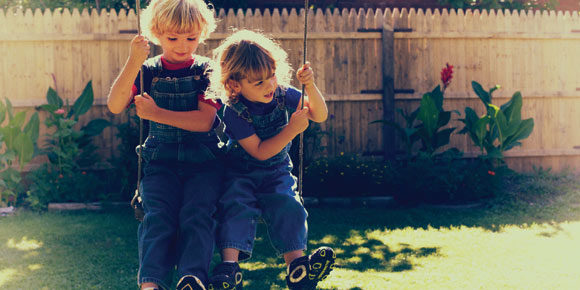By Cathie Ericson
Room for a nursery? Check. Good school district? Check. Home buyers with kids (or who hope to have kids soon) know to look for properties with certain kid-friendly characteristics ... but do you know all the things you should check?
Confession: I actually ended up buying a home that I thought would be perfect for my family, but once I moved in, I realized it was missing certain things that could have made my life there a whole lot easier. So just to be safe, check out this list of features that parents should factor into their house hunt, but often miss. Make sure they’re on your radar, so you don’t buy a place you regret!
1. Bedroom placement
When I was house hunting as a new mom, all that mattered to me with the nursery was that it had enough room for a rocker, changing table, and crib. Yet what I didn’t ponder seriously was the fact that our master suite was on the main floor, and the nursery one flight up. That meant I was running up and down those stairs nonstop, prompting me to grumble (often), “In our next home, all bedrooms will be upstairs!”
While parents know to find a house with ample bedrooms for their kids, what they sometimes fail to factor in is where those bedrooms are. Many parents prefer a layout where their kids’ bedrooms are fairly close to their own, since it keeps their kids within earshot at night. However, bedrooms on separate floors can work for parents who prefer a bit more privacy.
2. Sidewalks
Many parents are wary of buying homes on busy streets, lest their little tykes end up chasing baseballs into oncoming traffic. For this reason, the best option is a cul-de-sac.
But here’s what’s often overlooked: sidewalks. They offer an extra layer of safety, since they provide a buffer between cars and kids at play, and are crucial during the stroller/trike/wagon phase. But that’s not all. “Sidewalks invite you to go for a family walk. They’re the perfect place to set up a lemonade stand, and they make an ideal canvas to show off your mad art skills with sidewalk chalk,” says Ali Wenzke, a Chicago-based author who is writing a book called “The Art of Happy Moving.”
3. An open floor plan
While bonus rooms and basements are nice for corralling rambunctious kids, they’re not so great for toddlers who have to be constantly supervised. This is why the “great room” concept, with the kitchen, dining, and family room all opening onto one another, still rules for families.
“When your kids are young, they need to be in clear sight while you are working or preparing dinner,” recommends residential real estate expert Alison Bernstein of Suburban Jungle. “So make certain the home has enough space on the main floor for kids to play, where you can still go about your chores.”
4. Easy sightlines to the backyard
All parents know the importance of having a yard, but unless you plan to go outside every time they do, you’ll also want to check how viewable that yard is from indoors. Are the kitchen windows situated so you can cook and clean while the kids play Wiffle Ball out back? Or if you work from home, does your desk have a clear view of your kids’ sandbox or swing set? Trust us, a backyard won’t give you much peace of mind if you can’t keep an eye on your kids.
5. Hot spots
How a home is heated can present certain problems, too. Just ask mom Amanda Winn Lee. Her 1942 house had a type of heater that consists of a large metal grate on the floor, where the heat wafts out. One winter day, her son stood on top of the grate and ended up with second-degree burns on the bottoms of his feet. “The next week, we took out a loan and had central heating installed,” she says.
Radiators can also get piping hot — and if you have a gas fireplace? Yes, they are cozy, but also dangerous. Within three minutes, the glass doors can become hot enough to cause third-degree burns, and it takes about 45 minutes for the glass to cool down sufficiently, says the Consumer Safety Product Commission. (When my kids were little, I put duct tape over the “on” switch so a sitter wouldn’t inadvertently turn it on.)
6. Amenities within walking distance
While most people love the option of being within walking distance of stores and restaurants, this desire is particularly heightened for families with young children, who quickly realize how burdensome it gets to pack up the car with strollers and bags. So check the surrounding area to see what’s walkable — a coffee shop? Playground? Day care? It’ll make a huge difference.
Your REALTOR® will help you in researching these requirements when you’re searching for that perfect family home.
— realtor.com



